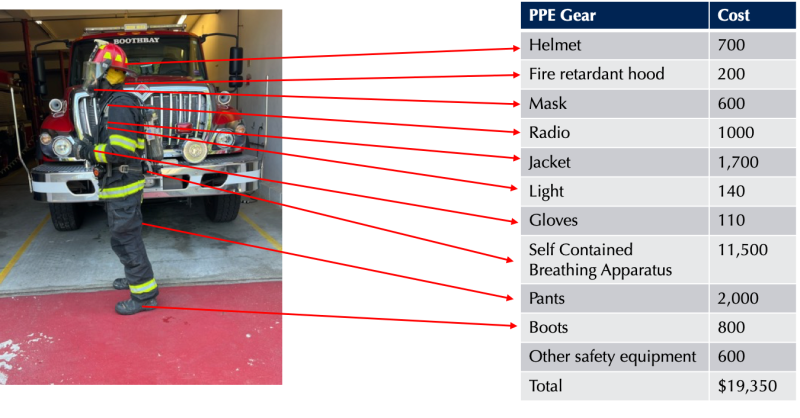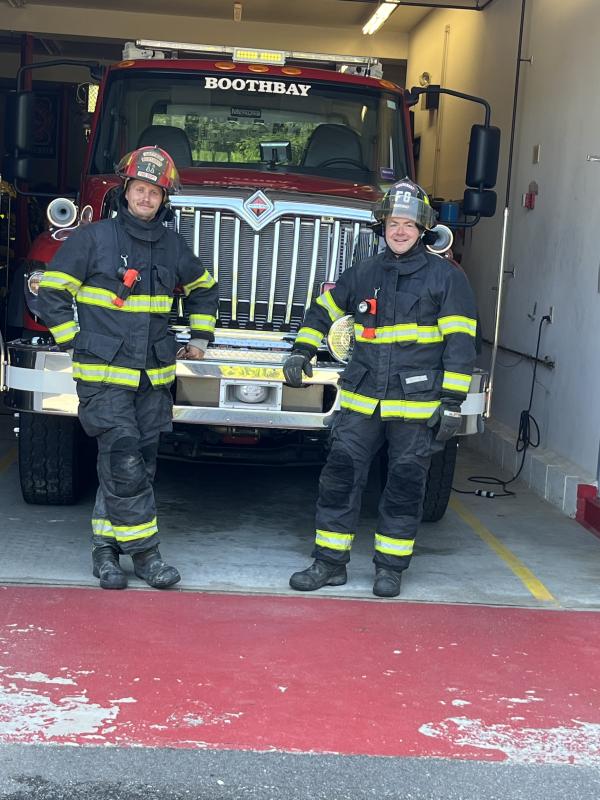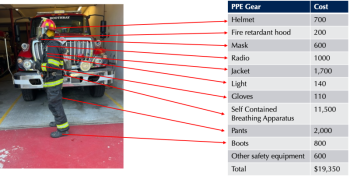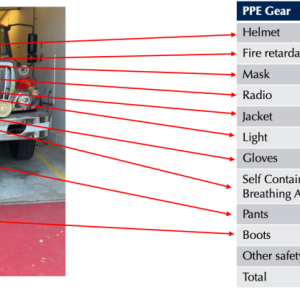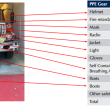Chief’s Column – Fire department operating costs and new federal OSHA regulations
As we close the last vestiges of summer, I wanted to also take this opportunity to shift gears from our typical fire prevention and education topics and discuss with you two very important issues that are affecting fire departments not only in Maine, but throughout the entire country. Additionally, at the end of the column we will also continue our firefighter profile series, with a focus on Ryan Murphy and Jonathan Tindal so please read through the article to learn more about our great team.
Over the last several years, and as you have personally experienced in your own lives and families, inflation combined with various shortages of goods and services have significantly increased prices. Fire departments have not been immune to this issue, and due to the complexity and safety related requirements associated with firefighting equipment, as well as the relatively small supply chain and manufacturing base for this type of equipment for fire departments, costs increases have been very significant and have had to be addressed by volunteer departments using firefighting grants, fund raising and community and company donations. This requires volunteer firefighters at each department to work hundreds, and in some cases thousands of hours, unpaid each year to raise money to replace old and worn-out gear or meet changing as well as new critical safety standards.
As the accompaning picture describes, the typical costs to outfit a firefighter is now approaching $15,000 - $20,000. The Personal Protection Equipment (PPE) depicted here is essential to allow firefighters to penetrate and attack fires in residential and commercial structures, where temperatures exceeding 800 degrees and firefighters often operate in zero visibility conditions. Additionally, during car accidents and other rescue related incidents, this equipment protects firefighters from sharp debris, explosions and hazardous materials spills, metal and glass, and allows them to safely rescue trapped victims.
Other examples of typical costs incurred by towns and fire departments include procurement of fire apparatus, and depending on the type of vehicle – pumpers, rescue or ladder trucks- these can cost between $400K and $1.2m. Radios required to communicate between fire trucks and other responding departments, and firefighters in burning buildings cost between $800 - $1,200, a positive/negative ventilation fan for dealing with smoke in a structure fire can cost between $5,000 - $7,000. These are some of the more noteworthy costs, however from fire hoses and nozzles to basic supplies fire department operating costs are substantial and have increased dramatically over the last several years while most town budgets for fire departments have remained flat or have had marginal increases.
The second aspect of this issue affecting fire departments is regarding the Federal Occupational Safety and Health Administration (OSHA) fire safety regulations, which the agency is looking to drastically update rules that were originally written in 1980, and which they believe fail to address modern firefighting job hazards. “Currently, OSHA regulations protect emergency responders’ safety and health in a patchwork of decades-old, hazard-specific standards” the agency said in a press release. The newly named ‘Emergency Response’ standard updates safety and health protections in line with national consensus standards for a broad range of workers exposed to hazards that arise during and after fires and other emergencies.
The rules that are now under consideration — collectively titled the Emergency Response Standard — would fully replace the Fire Brigades Standard and be applicable not only to firemen, but to other types of emergency personnel as well.
While no one can argue about improving firefighting and emergency responder safety, and this revamp of fire regulations is widely supported in the fire service across the country, what is a significant issue and concern by all fire departments is that this federal mandate is unfunded – meaning, local towns and municipalities will be fully expected to bear the financial burden of implementing these changes. Additionally, the time period in which OSHA is expecting departments to comply is widely regarded to be unachievable.
The 982-page OSHA document includes changes that will affect every aspect of a department, and a small sampling of the new requirements include the following:
· Mandatory replacement of fire apparatus after 20 years in service (Boothbay has three vehicles nearing or over this requirement that are 26, 23 and 18 years or age). Replacement of trucks from ordering to in service can take 24-36 months and can cost between $400,000 and $1,200,000
· Mandatory replacement of Firefighter Personal Protection equipment every 10 years ($5,000 per firefighter)
· Training and Certification Requirements: Under the proposed standard, officers would be mandated to obtain Fire Officer certifications corresponding to their ranks, potentially escalating spending on training programs.
· Specialized training for hazards like HazMat and vehicle operations may also be necessary.
· Documentation and Administrative Burden: Compliance with the proposed standard could lead to additional administrative tasks and documentation requirements further requiring fire departments to allocate resources toward. The National Volunteer Fire Council estimates additional hours of documentation could cost departments up to $4,800 per year.
· Equipment Upgrades and Maintenance: Fire departments may need to invest in new equipment, upgrades to personal protective equipment (PPE), and communications systems to ensure compliance with the new standard.
· Infrastructure and Facility Upgrades: Compliance with the proposed standard could require significant infrastructure upgrades or modifications to fire department facilities to accommodate training facilities, control zones, fitness rooms, decontamination areas, and storage areas.
· Legal and Compliance Costs: Fire departments may need to budget for legal counsel, compliance audits, and risk management to address liability concerns and ensure compliance.
· Requiring apparatus bay exhaust systems, sprinklers
· Firefighters would have to have an annual basic medical physical based on their type and level of work with an estimated annual cost of $800 per firefighter.
· SCBA and interior firefighters would require more stringent medical and physical evaluations with costs ranging from $10,000-$15,000 and would include a full “fit-for-duty” physical, EKG, PFT, and other medical procedure testing with cardiovascular health as a particular focus.
“The staffing, training, financial and service delivery impacts of this proposed standard could be overwhelming for many departments and communities, forcing them to make drastic decisions, perhaps closing doors,” said the Maine Fire Chiefs Associations in their testimony to OSHA.
“Those impacts could have a domino effect on neighboring response areas who are able to address impacts for their current service area,” the Association wrote To put some context on the magnitude of this issue this according to the U.S. Fire Administration, the vast majority of fire departments in Maine are entirely (69.3 percent) or mostly (23.8 percent) volunteer-based and the new rules proposed by the Occupational Safety and Health Administration (OSHA) are expected to have a detrimental impact on Maine’s rural volunteer fire departments due to the estimated cost of compliance. According to the National Volunteer Fire Council, the time donated by volunteer firefighters saves the country almost $47 billion annually. These rules and regulations would undoubtedly force some volunteers to resign from the fire service, due to the greatly increased training requirements, and associated time this would take from their full-time jobs and families.
Netting all this out, the financial impact on volunteer departments is estimated to range from $100K – to several million departments, the later number driven by truck replacement costs.
What can you do?
Maine senate and congressional representatives are aware of the issue and have voiced their strong concern over this new regulation to OSHA, as well as the lack of funding to support local towns with complying to these mandates. Please feel free to reach out to your elected officials to voice your concern over not only the financial impact, but also the real risk of critical volunteer firefighters leaving the fire service, which will undoubtedly have serious first responder implications across our country.
Finally, in today’s column we will profile two firefighters – Ryan Murphy and Jonathan Tindal – two of our outstanding officers who play a critical role in handling complex structure fires and car accidents. I have had the privilege of watching them continue to grow over the years and become great frontline officers and leaders and they have played a critical role in the development of our newer members.
|
Questions |
Ryan Murphy |
Jonathan Tindal |
|
Years at Boothbay Fire |
9
|
11 |
|
Role |
Captain |
Lieutenant |
|
Full-time employer: |
Boothbay Harbor Sewer District
|
Tindal & Callahan Real Estate |
|
Why did you join the fire service: |
My father was in the fire service, so I grew up surrounded by firefighters and the family that they became. After high school I joined the Navy and served on submarines for three years and when I returned home, I missed the comradery and joined the fire department. I have an immense amount of pride that I’m able to follow in my late father’s footsteps.
|
My brother-in-law, Tim Pinkham, encouraged me to consider joining. Through Tim, I met several firemen, and was struck by their passion for helping others. That motivated me to join. |
|
What do you like best? |
I like that every call is always different. No matter what the call is, the time of day there are so many factors that play into responding. I enjoy serving my community. It may be someone’s worse day and we’re there to help them in whatever way we can.
|
Nobody's in the fire service for fortune or fame; everybody who responds to an incident is there to help others, and that selflessness makes for excellent teamwork. Camaraderie is built through this collective effort and cooperation.
|
|
What have you learned since joining? |
In the Navy I had acquired some shipboard firefighting skills, but nothing compared to the skills that I have learned in the classes I have taken since. There’s a lot more to being a firefighter than just showing up and putting out fires. There’s a lot of techniques and situational awareness that is required to do what we do. I am looking forward to taking an instructor class in the near future.
|
Our department, and others in the County, provides great training opportunities. Firefighter I & II certification has given me the skills to contribute with confidence. Through our calls, I've learned about fire science, car accidents and patient extrication, coordinated response to severe weather events, etc. Another thing I've learned is that everything changes in the blink of an eye; I see this especially with car accidents, but generally, people involved in incidents of any type weren't expecting it when their day started. It's made me more attentive and prepared in my own day-to-day life, whether driving, checking smoke detectors, fire extinguishers, or surge protectors, developing a family plan for an emergency, etc. |

